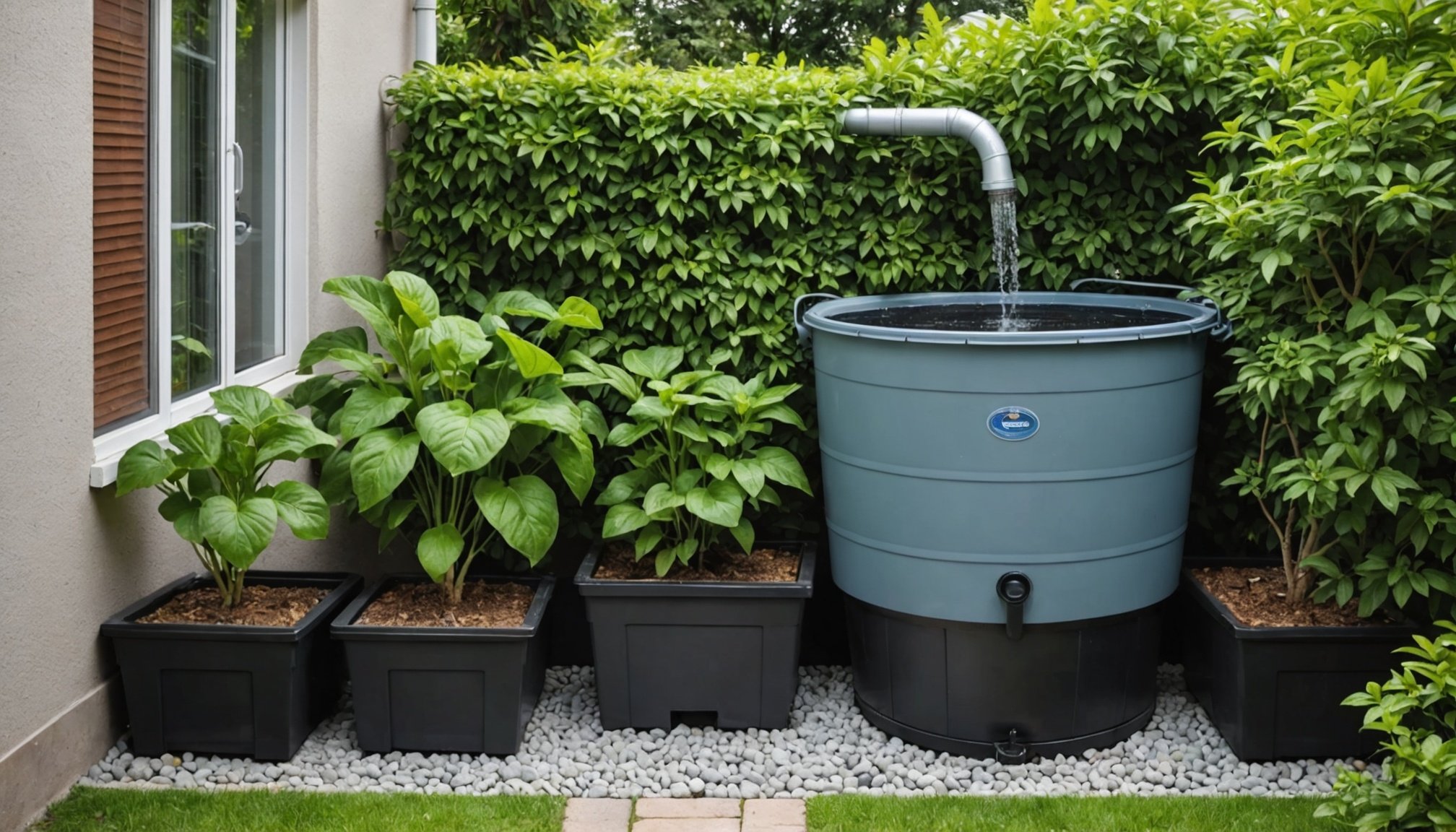Revitalize Your Terrace Garden: The Ultimate Guide to Installing a Rainwater Harvesting System
Why Rainwater Harvesting is Essential for Your Garden
In an era where water conservation is more crucial than ever, installing a rainwater harvesting system can be a game-changer for your terrace garden. Not only does it help in reducing your water bill, but it also contributes to a more sustainable and eco-friendly way of managing water resources.
“Collecting rainwater minimizes the strain on municipal water treatment facilities and conserves precious groundwater resources,” notes a guide from Dr. Fixit[1].
In parallel : Elevate your home yoga sanctuary: build a sustainable studio with eco-friendly materials
Here are some key benefits of rainwater harvesting that make it an attractive option for garden enthusiasts:
- Environmental Impact: By collecting rainwater, you reduce the burden on municipal water treatment facilities and help conserve groundwater.
- Cost Savings: Rainwater is free, and using it for activities like watering plants, washing vegetables, or even flushing toilets (with proper filtration) can significantly lower your water bill.
- Improved Plant Growth: Rainwater is naturally soft and free of chlorine and other chemicals, making it ideal for nourishing your plants and promoting healthy growth.
- Reduced Stormwater Runoff: Harvesting rainwater helps manage stormwater runoff, which can cause flooding and erosion, contributing to a healthier local environment.
Preparing Your Roof for Rainwater Collection
Before you can start collecting rainwater, it’s essential to ensure your roof is ready for the task. Here’s a step-by-step guide to prepare your roof:
Also read : Revamp your home theater: ultimate guide to designing acoustic panels for exceptional sound quality
Evaluate Your Roof
Ensure your roof is made of sturdy materials such as good-quality tiles or cement. Avoid roofs with asphalt shingles or those treated with chemicals, as they can contaminate the rainwater[1].
Clean the Roof Surface
Thoroughly clean the roof to remove debris, leaves, and other contaminants. This step is crucial to ensure the rainwater you collect is clean and free from impurities.
Install a Gutter System
An efficient gutter system is vital for channeling rainwater towards your collection tank. Ensure the gutters are suitably sized and angled, and check for any leaks or clogs regularly.
Waterproofing is Key
Proper rooftop and basement waterproofing is essential to prevent leakage, structural damage, and contamination of rainwater. Use waterproofing materials to ensure a durable harvesting system[1].
Divert Water to Collection Tank
Install a sturdy spout or diverter to channel the rainwater collected from the gutters into your storage tank.
Designing Your Rainwater Harvesting System
Designing an effective rainwater harvesting system involves several key components:
Choosing the Right Storage Tank
The storage tank is the heart of your rainwater harvesting system. Here are some factors to consider when choosing a tank:
| Type of Tank | Advantages | Disadvantages |
|---|---|---|
| Plastic Tanks | Lightweight, easy to install, and relatively inexpensive. | May degrade over time, especially when exposed to sunlight. |
| Metal Tanks | Durable and can last for decades. | Can be heavy, expensive, and may rust if not properly coated. |
| Concrete Tanks | Highly durable and can be customized to fit your space. | Heavy, expensive, and may require professional installation. |
| Wooden Tanks | Aesthetic appeal, can be built DIY. | Requires regular maintenance to prevent rot and insect damage[5]. |
Sizing Your System
The size of your system depends on several factors, including the area of your roof, the amount of rainfall in your area, and your water usage needs.
- Roof Area: Calculate the square footage of your roof to determine how much rainwater you can collect.
- Rainfall: Check the average rainfall in your area to estimate the volume of water you can harvest.
- Water Usage: Determine how much water you plan to use from the harvested rainwater to size your storage tank appropriately.
Overflow and Backup Systems
It’s crucial to have an overflow system in place to manage excess water during heavy rainfall events. This can include a secondary storage tank or a drainage system that directs excess water away from your home.
Installing Your Rainwater Harvesting System
Installing a rainwater harvesting system can be a DIY project, but it may also require professional help, especially for larger systems.
DIY vs. Professional Installation
While many parts of a rainwater harvesting system can be installed by a handy DIYer, some components, like the tank, may require professional expertise.
- DIY: For smaller systems, you can use online tools and guides to assemble your own rain barrel system. Companies like BlueBarrel Systems provide comprehensive DIY kits and instructions[4].
- Professional Installation: For larger or more complex systems, it’s advisable to hire professionals who are certified by organizations like the American Society of Sanitary Engineering (ASSE)[2].
Key Components of the System
Here are the key components you’ll need for a complete rainwater harvesting system:
- Gutters and Downspouts: Direct rainwater from the roof to the storage tank.
- First Flush Device: Allows the first flow of water from the roof to be diverted, taking any debris and contaminants with it, and then allows clean water to flow into the tank.
- Screen and Mesh: Prevents leaves and other debris from entering the tank.
- Pumps and Filters: Depending on your intended use, you may need pumps to distribute the water and filters to ensure the water quality is suitable for your needs.
Maintaining Your Rainwater Harvesting System
Regular maintenance is crucial to ensure your rainwater harvesting system operates efficiently and safely.
Cleaning Gutters
Regularly remove leaves, debris, and other obstructions from your gutters to ensure proper water flow.
Inspecting Roof and Tank
Periodically inspect your roof for any leaks or damage and address them promptly. Also, check your storage tank for cracks or blockages and clean it as needed[1].
Water Tank Treatment
Depending on your intended use of the collected rainwater, consider treating it with a filtration system to ensure its potability for specific applications.
Waterproofing and Inspections
Ensure that your rooftop and basement are properly waterproofed during installation to mitigate the chances of contamination, mold growth, and mildew.
Regulatory Considerations
If you plan to use harvested rainwater for potable purposes or even for non-potable uses, there are regulatory considerations you need to be aware of.
Registration and Permits
In many regions, you need to register your rainwater harvesting system and obtain necessary permits, especially if the system is intended for human consumption. For example, in Virginia, owners of new rainwater harvesting systems must file a registration form with the Virginia Department of Health (VDH) within 30 days of installation[2].
Compliance with Regulations
Ensure that your system complies with local and state regulations. This includes obtaining construction and operating permits, and having your system designed, installed, and inspected by certified professionals.
Practical Tips and Examples
Here are some practical tips and examples to help you get the most out of your rainwater harvesting system:
Using Rain Barrels
If you’re on a tight budget or prefer a simpler approach, consider using rain barrels. These can be placed under your downspouts and are a great way to collect rainwater for watering your garden or other non-potable uses[3].
Integrating with Your Garden
You can integrate your rainwater harvesting system with your garden by using the collected water for irrigation. This not only saves water but also provides your plants with naturally soft and chemical-free water.
Winterizing Your System
In colder climates, it’s important to winterize your rainwater harvesting system to prevent damage from freezing temperatures. This includes draining the system, insulating pipes, and protecting the tank from frost[4].
Installing a rainwater harvesting system is a rewarding project that not only helps you save money but also contributes to a more sustainable future. By following the steps outlined in this guide, you can ensure that your system is efficient, safe, and beneficial for your garden.
“Rainwater harvesting is a simple yet powerful technique for collecting rainwater for later use,” and with the right design, installation, and maintenance, it can be a valuable asset for any homeowner looking to make their garden more eco-friendly and sustainable[1].
So, take the first step today and start harvesting rainwater to revitalize your terrace garden and contribute to a greener tomorrow.



